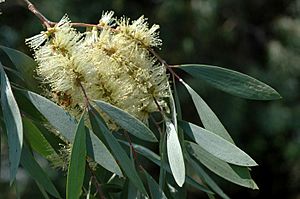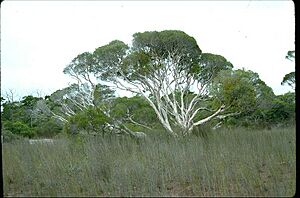Cajuput facts for kids
Quick facts for kids Cajuput |
|
|---|---|
 |
|
| M. cajuputi flowers and leaves | |
| Scientific classification | |
| Genus: |
Melaleuca
|
| Species: |
cajuputi
|
 |
|
The Cajuput tree, also called cajuput or white samet, is a plant from the Myrtaceae family, which includes myrtle. It grows widely in Australia, Southeast Asia, New Guinea, and the Torres Strait islands. This tree can be medium or tall. It has bark that looks like paper and new leaves that are silvery. Its flowers are white or greenish. A special oil called cajuput oil comes from this tree.
Contents
What the Cajuput Tree Looks Like
The Cajuput tree is usually a medium to large tree. It often grows as tall as 35 meters (about 115 feet). Some can even reach 46 meters (about 150 feet) high. It has bark that can be grey, brownish, or whitish and feels like paper.
When new leaves grow, they are soft and hairy. As they get older, they become smooth. The leaves are usually 40 to 140 millimeters (about 1.5 to 5.5 inches) long. They are also 7.5 to 60 millimeters (about 0.3 to 2.4 inches) wide. They get narrower at both ends.
The flowers are white, cream, or greenish-yellow. They usually grow in thick groups at the ends of the branches. New parts of the branch keep growing even after the flowers appear. Flowers can also be found where the upper leaves meet the stem. Each group of flowers has three individual flowers. The flowers have stamens (the parts that make pollen) grouped into five bundles. Each bundle has 6 to 18 stamens. The time when the tree flowers can be different for various types of Cajuput trees.
After flowering, the tree produces woody, cup-shaped fruits. These fruits grow in loose clusters along the branches. Each fruit is about 2 to 2.8 millimeters (about 0.08 to 0.11 inches) long.
How the Cajuput Tree Got Its Name
The Cajuput tree was first officially described in 1809 by Thomas Powell. He wrote about it in a book called Pharmacopoeia of the Royal College of Physicians of London. He referred to an earlier description from 1747 by Rumphius.
The tree's scientific name, cajuputi, likely comes from an Indonesian name. "Kayu putih" in Indonesian means "white wood."
Different Types of Cajuput Trees
There are three main types, or subspecies, of Melaleuca cajuputi:
- Melaleuca cajuputi subsp. cajuputi: This type has leaves that are 7 to 26 millimeters (about 0.3 to 1 inch) wide. It usually flowers from March to November.
- Melaleuca cajuputi subsp. cumingiana (Turcz.) Barlow: This type flowers from February to December. Its leaves are longer, about 40 to 200 millimeters (about 1.6 to 7.9 inches) long. This subspecies is named after Hugh Cuming.
- Melaleuca cajuputi subsp. platyphylla Barlow: This type has wider leaves, about 15 to 60 millimeters (about 0.6 to 2.4 inches) wide. It flowers from January to May and again from August to September. The name platyphylla comes from Greek words meaning "flat" or "wide" and "leaf."
Where the Cajuput Tree Grows
The different types of Cajuput trees grow in various places:
- Melaleuca cajuputi subsp. cajuputi is found in parts of Western Australia, the northern Northern Territory, and East Timor. It grows in woodlands, vine forests, and savannah forests. It prefers clayey and peaty soil.
- Melaleuca cajuputi subsp. cumingiana grows in Myanmar, Thailand, Vietnam, Malaysia, and parts of Indonesia. It likes to grow in swamp forests near the coast. In Thailand, this tree is known as White Samet.
- Melaleuca cajuputi subsp. platyphylla is found in New Guinea, the Torres Strait islands, and north-western Queensland in Australia. It grows in similar places as subsp. cajuputi.
How People Use the Cajuput Tree
Wood Uses
In Southeast Asia, people use the wood from the Cajuput tree as fuel. They also use it to make charcoal for cooking and heating. On a smaller scale, the wood is used to build houses. It can be used for supporting poles, frames, and floorboards. It is also used for fences. The tree's papery bark has been used as a roofing material. It is also used to seal boats, helping to make them waterproof in Indonesia.
Essential Oils
Indigenous Australian people traditionally used the leaves of the Cajuput tree. They would crush the leaves to treat aches and pains. They also breathed in the steam from the crushed leaves to help with breathing problems. In Thailand, people use the leaves to make a herbal tea. This tea is used to help with various health issues.
In many parts of Asia, an oil called cajuput oil is made from the tree. This oil is used as a rub for the skin and as something to inhale. It helps with pain and breathing.
Most of the cajuput oil sold comes from Melaleuca cajuputi subsp. cajuputi. This oil is a pale yellow liquid. It contains a lot of a substance called 1,8-cineole, which helps fight germs. Cajuput oil is generally considered safe for use. However, it might cause skin irritation if used in very strong amounts.
Some reports say cajuput oil can help keep insects away. It might also help people feel calm and relaxed. It has been used to treat certain types of worms. Cajuput oil is also used to add flavor to foods. It is also added to soaps and cosmetics to give them a nice smell.
Images for kids
See also
 In Spanish: Aceite de cajeput para niños
In Spanish: Aceite de cajeput para niños



